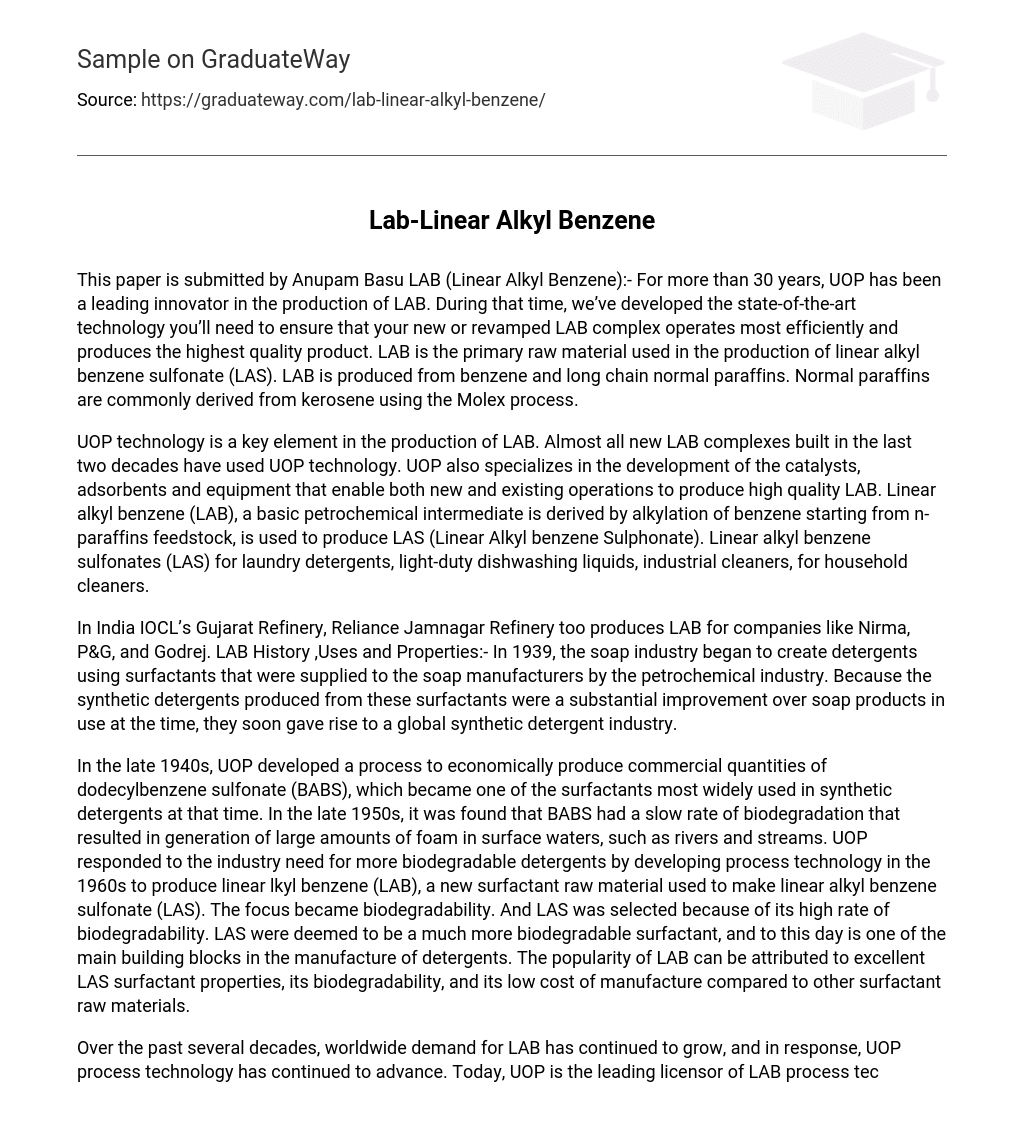This paper is submitted by Anupam Basu LAB (Linear Alkyl Benzene):- For more than 30 years, UOP has been a leading innovator in the production of LAB. During that time, we’ve developed the state-of-the-art technology you’ll need to ensure that your new or revamped LAB complex operates most efficiently and produces the highest quality product. LAB is the primary raw material used in the production of linear alkyl benzene sulfonate (LAS).
LAB is produced from benzene and long chain normal paraffins. Normal paraffins are commonly derived from kerosene using the Molex process. UOP technology is a key element in the production of LAB. Almost all new LAB complexes built in the last two decades have used UOP technology. UOP also specializes in the development of the catalysts, adsorbents and equipment that enable both new and existing operations to produce high quality LAB. Linear alkyl benzene (LAB), a basic petrochemical intermediate is derived by alkylation of benzene starting from n-paraffins feedstock, is used to produce LAS (Linear Alkyl benzene Sulphonate). Linear alkyl benzene sulfonates (LAS) for laundry detergents, light-duty dishwashing liquids, industrial cleaners, for household cleaners.
In India IOCL’s Gujarat Refinery, Reliance Jamnagar Refinery too produces LAB for companies like Nirma, P&G, and Godrej. LAB History ,Uses and Properties:- In 1939, the soap industry began to create detergents using surfactants that were supplied to the soap manufacturers by the petrochemical industry. Because the synthetic detergents produced from these surfactants were a substantial improvement over soap products in use at the time, they soon gave rise to a global synthetic detergent industry. In the late 1940s, UOP developed a process to economically produce commercial quantities of dodecylbenzene sulfonate (BABS), which became one of the surfactants most widely used in synthetic detergents at that time.
In the late 1950s, it was found that BABS had a slow rate of biodegradation that resulted in generation of large amounts of foam in surface waters, such as rivers and streams. UOP responded to the industry need for more biodegradable detergents by developing process technology in the 1960s to produce linear lkyl benzene (LAB), a new surfactant raw material used to make linear alkyl benzene sulfonate (LAS). The focus became biodegradability. And LAS was selected because of its high rate of biodegradability. LAS were deemed to be a much more biodegradable surfactant, and to this day is one of the main building blocks in the manufacture of detergents. The popularity of LAB can be attributed to excellent LAS surfactant properties, its biodegradability, and its low cost of manufacture compared to other surfactant raw materials.
Over the past several decades, worldwide demand for LAB has continued to grow, and in response, UOP process technology has continued to advance. Today, UOP is the leading licensor of LAB process technology in the world. Linear alkyl benzene sulfonate (LAS), is the most cost-effective surfactant available for use in detergent formulations. Environmentally proven LAS has the largest volume among existing surfactants. For the production of LAB, usually C10 to C13, C11 to C14, or C10 to C14 n-paraffins are used. LAS eliminate dirt by its physicochemical mechanism and it is one of the surfactants most widely used in liquid cleaners and in powder.
LAS have been used for years in the manufacture of detergents and it is known for its excellent quality price ratio. Under normal weather conditions, linear alkyl benzene is a transparent, odourless liquid. Linear Alkylbenzene and linear alkyl benzene sulfonate are entirely biodegradable and do not accumulate in the environment. In brief, linear alkyl benzene is the combination of a paraffin molecule and a benzene molecule. The benzene molecule has an affinity for that of paraffin. On the other hand, the paraffin molecule is not ready to receive the benzene molecule. Modifications are thus necessary. The total world LAB production capacity in 2002 was estimated at 2. 5 million tons, with 300, 000 tons being consumed in Western Europe. LAS currently represents one-third of the active ingredients in detergents worldwide. Virtually all LAB is transformed into LAS.





